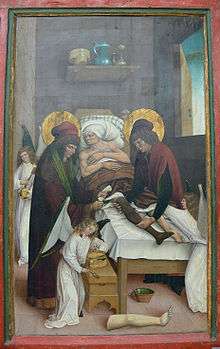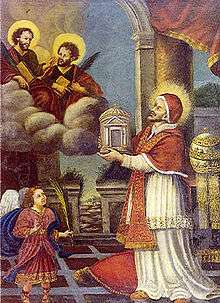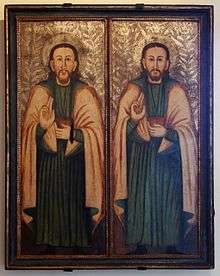Saints Cosmas and Damian
| Saints Cosmas and Damian | |
|---|---|
 Icon of Saints Cosmas (left) and Damian (right) one holding a urine bottle and the other a medicine box | |
| Martyrs | |
| Born |
c. 3rd century Arabia |
| Died |
c. 287 Aegea, Roman province of Syria |
| Venerated in |
Roman Catholic Church Eastern Orthodox Churches Oriental Orthodox Churches Eastern Catholic Churches |
| Major shrine | Convent of the Poor Clares in Madrid, Basilica of Saints Cosmas and Damian in Bitonto, Bari, Italy |
| Feast |
|
| Attributes | depicted as twins, beheaded, or with medical emblems |
| Patronage | surgeons, physicians, dentists, protectors of children, barbers, pharmacists, veterinarians, orphanages, day-care centers, confectioners, children in house, against hernia, against the plague. |
Saints Cosmas and Damian (Greek: Κοσμάς και Δαμιανός, Kosmás kai Damianós; Latin: Cosmas et Damianus; died c. AD 287) were reputed twin brothers, physicians, and early Christian martyrs. They practiced their profession in the seaport of Aegeae, then in the Roman province of Syria.
Accepting no payment for their services led to them being named Anarguroi (Ανάργυροι, "Unmercenaries"); it has been said that, by this, they attracted many to the Christian faith.[3]
Lives
.jpg)
Nothing is known of their lives except that they suffered martyrdom in Syria during the persecution of the Emperor Diocletian. According to Christian traditions, the twin brothers were born in Arabia and became skilled doctors.[4] Saladino d'Ascoli, a 15th century Italian physician, claims that the medieval electuary known as opopira, a complex compound medicine used to treat diverse maladies including paralysis, was invented by Cosmas and Damian.[5] During the persecution under Diocletian, Cosmas and Damian were arrested by order of the Prefect of Cilicia, one Lysias who is otherwise unknown, who ordered them under torture to recant. However, according to legend they stayed true to their faith, enduring being hung on a cross, stoned and shot by arrows and finally suffered execution by beheading. Anthimus, Leontius and Euprepius, their younger brothers, who were inseparable from them throughout life, shared in their martyrdom.
Their most famous miraculous exploit was the grafting of a leg from a recently deceased Ethiopian to replace a patient's ulcered or cancerous leg, and was the subject of many paintings and illuminations.[6][7]
Veneration



As early as the 4th century, churches dedicated to the twin saints were established at Jerusalem, in Egypt and in Mesopotamia. Devotion to the two saints spread rapidly in both East and West. Theodoret records the division of their reputed relics. Their relics, deemed miraculous, were buried in the city of Cyrrus in Syria. Churches were built in their honor by Archbishop Proclus and by Emperor Justinian I (527–565), who sumptuously restored the city of Cyrus and dedicated it to the twins, but brought their purported relics to Constantinople; there, following his cure, ascribed to the intercession of Cosmas and Damian, Justinian, in gratitude also built and adorned their church at Constantinople,[4] and it became a celebrated place of pilgrimage. At Rome Pope Felix IV (526–530) rededicated the Library of Peace (Bibliotheca Pacis) as a basilica of Santi Cosma e Damiano in the Forum of Vespasian in their honour. The church is much rebuilt but still famed for its sixth-century mosaics illustrating the saints.
What are said to be their skulls are venerated in the convent of the Clares in Madrid, where they have been since 1581, the gift of Maria, daughter of Emperor Charles V. They had previously been removed from Rome to Bremen in the tenth century, and thence to Bamberg. Other skulls said to be theirs were discovered in 1334 by Burchard Grelle, Archbishop of Bremen. He "personally 'miraculously' retrieved the relics of the holy physicians Cosmas and Damian, which were allegedly immured and forgotten in the choir of the Bremen Cathedral.[8] In celebration of the retrieval Archbishop and Chapter arranged a feast at Pentecost 1335, when the relics were translated from the wall to a more dignified place.[9] Grelle claimed the relics were those Archbishop Adaldag brought from Rome in 965. The cathedral master-builder Johann Hemeling made a shrine for the relics, which was finished around 1420. The shrine,made from carved oak wood covered with gilt and rolled silver is considered an important mediaeval gold work.[10] In 1649 Bremen's Chapter, Lutheran by this time, sold the shrine without the heads to Maximilian I of Bavaria. The two heads remained in Bremen and came into the possession of the small Roman Catholic community. They were shown from 1934 to 1968 in the Church of St. Johann and in 1994 they were buried in the crypt.[11] The shrine is now shown in the Jesuit church of St Michael in Munich. At least since 1413 another supposed pair of skulls of the saints has been stored in St Stephens's Cathedral in Vienna. Other relics are claimed by the Church of San Giorgio Maggiore in Venice.

The martyr twins are invoked in the Canon of the Mass[4] in the prayer known as the Communicantes (from the first Latin word of the prayer): "In communion with the whole Church, they venerate above all others the memory of the glorious ever-virgin Mary, Mother of our God and Lord, Jesus Christ, then of blessed Joseph, husband of the Virgin, your blessed Apostles and Martyrs, Peter and Paul, Andrew, James, ...John and Paul, Cosmas and Damian and all your Saints: grant through their merits and prayers that in all things we may be defended by the help of your protection." They are also invoked in the Litany of the Saints, and in the older form of the Roman rite, in the Collect for Thursday in the Third Week of Lent, as the station church for this day is Santi Cosma e Damiano.
Their feast day in the General Roman Calendar, which had been on September 27, was moved in 1969 to September 26, because September 27 is the dies natalis ("day of birth" into Heaven) of Saint Vincent de Paul, now more widely venerated in the Latin Church.[12]
Sts Cosmas and Damian are regarded as the patrons of physicians and surgeons and are sometimes represented with medical emblems.
_-_Walters_27572.jpg)
In Brazil, the twin saints are regarded as protectors of children, and September 27 is commemorated, especially in Rio de Janeiro, by giving children bags of candy with the saints' effigy printed on them and throughout the entire state of Bahia where Catholics and adepts of Candomblé religion offer typical food such as carurú. The ritual consists of first offering the food to seven children that are no older than seven years old and then having them feast while sitting on the floor and eating with their hands. Only after all children have finished can the guests enjoy the food that is being offered. The Church of Saints Cosmas and Damian, in Igarassu, Pernambuco is Brazil's oldest church, built in 1535.
In the UK St Damian is the dexter side supporter in the coat of arms of the British Dental Association.
Sts. Cosmas & Damian are venerated every year in Utica, New York at St. Anthony's Parish during the annual pilgrimage which takes place on the last weekend of September (close to the Sept. 27 feast day). There are thousands of pilgrims who come to honor the saints. Over 80 busloads come from Canada and other destinations. The 2-day festival includes music (La Banda Rosa), much Italian food, masses and processions through the streets of East Utica. It is one of the largest festivals honoring saints in the northeast USA.
Eastern Christianity
In the Eastern Orthodox Church, Eastern Catholic Churches, and the Oriental Orthodox Churches, Saints Cosmas and Damian are venerated as a type of saint known as Unmercenary Physicians (Greek: ἀνάργυροι, anargyroi, "without money"). This classification of saints is unique to the Eastern Church and refers to those who heal purely out of love for God and man, strictly observing the command of Jesus: "Freely have you received, freely give." («Δωρεὰν ἐλάβετε, δωρεὰν δότε...» Matthew 10:8) While each of the Unmercenaries has his own feast days, all are commemorated together on the first Sunday in November, in a feast known as the Synaxis of the Unmercenary Physicians.
The Orthodox celebrate no less than three different sets of saints by the name of Cosmas and Damian, each with their own distinct feast day:
- Saints Cosmas and Damian of Cilicia (Arabia) (October 17) Brothers, according to Christian legend they were beaten and beheaded together with three other Christians: Leontius, Anthimus, and Eutropius.
- Saints Cosmas and Damian of Asia Minor — alternately, of Mesopotamia (November 1) Twin sons of Saint Theodota. Died peacefully and were buried together at Thereman in Mesopotamia.
- Saints Cosmas and Damian of Rome (July 1) Brothers, according to Christian tradition they were martyred outside Rome by a jealous pagan physician during the reign of the Roman Emperor Carinus (283–284).
Orthodox icons of the saints depict them vested as laymen holding medicine boxes. Often each will also hold a spoon with which to dispense medicine. The handle of the spoon is normally shaped like a cross to indicate the importance of spiritual as well as physical healing, and that all cures come from God.
In Rochester, Minnesota, home of the Mayo Clinic, the Greek Orthodox Church is the Holy Anargyroi/Sts. Kosmas & Damianos Greek Orthodox Church.

Churches
Australia
- St Mary & Sts Cozman and Demian Coptic Orthodox Church
- St Damians Catholic Church, Bundoora, Victoria
Croatia
England
In the Church of England, dedications of churches to SS Cosmas and Damian are very rare:
- Blean, Kent, church of St Cosmus [sic] and St Damian in the Blean;
- Challock, Kent;
- Keymer, Sussex, St Cosmas and St Damian Church, Keymer;
- Sherrington, Wiltshire, church of St Cosmo [sic] and St Damian, in the Benefice of the Upper Wylye Valley;
- Stretford, near Leominster, Herefordshire, church no longer in use and in the care of the Churches Conservation Trust.
France
- Saint Côme-Saint Damien church, Luzarches, Val d'Oise, France
- Saint Côme-Saint Damien church, Paris, France
- Saint Côme-Saint Damien church, Chamboulive, France
- Saint Côme-Saint Damien church, Serdinya, France
Goa
- Church of Saant Cosme ani Damiao, Bogmalo
Hungary
Italy
Russia
Serbia
Slovakia
- Kostol sv. Kozmu a Damiána, Bratislava - Dúbravka
- Kostol sv. Kozmu a Damiána, Trenčín - Biskupice
- Kostol sv. Kozmu a Damiána, Kšinná
Former Yugoslav Republic of Macedonia
- Sveti Kozma i Damjan - Pestani, Ohrid, Republic of Macedonia
References
_-_The_Charity_of_Saints_Cosmas_and_Damian.jpg)
- ↑ Great Synaxaristes: (Greek) Οἱ Ἅγιοι Κοσμᾶς καὶ Δαμιανός οἱ Ἀνάργυροι καὶ Θαυματουργοί. 1 Νοεμβρίου. ΜΕΓΑΣ ΣΥΝΑΞΑΡΙΣΤΗΣ.
- ↑ Wonderworker and Unmercenary Cosmas of Asia Minor. OCA - Feasts and Saints.
- ↑ Catholic Encyclopedia: "Sts. Cosmas and Damian"
- 1 2 3 Foley OFM, Leonard. "Sts. Cosmas and Damian", Saint of the Day, (revised by Pat McCloskey OFM), Franciscan Media
- ↑ Saladino d'Ascoli, "Compendium Aromatariorum", In: Mesue cum expositione mondini super canones vniuersales. ac etiam cum expositione Christophori de honestis in antidotarium eiusdem... Venecia, per Bonetum Locatellum Bergomensem. 1 abril 1495, fol. 323v: "Oppopira dicitur a succo & igne. oppo enim grece latine succus & pir grece latine ignis: inde oppopira idest succus ignitus & hoc electuarium compositum est a sanctissimis medicis cosma & damiano."
- ↑ Jacobus de Voragine (1275). The GOLDEN LEGEND or LIVES of the SAINTS.
- ↑ Androutsos, G.; Diamantis, A.; Vladimiros, L. (2008). "The first leg transplant for the treatment of a cancer by Saints Cosmas and Damian". Journal of B.U.ON. : official journal of the Balkan Union of Oncology 13 (2): 297–304. PMID 18555483.
- ↑ Cf. "Bremer Chronik von Gerhard Rinesberch und Herbord Schene", In: Bremen, Hermann Meinert (ed.) on behalf of the Historische Kommission bei der Bayerischen Akademie der Wissenschaften, Bremen: Schünemann, 1968, (Chroniken der deutschen Städte vom 14. bis ins 16. Jahrhundert; vol. 37: Die Chroniken der niedersächsischen Städte), p. 112,; Regesten der Erzbischöfe von Bremen, Joseph König and Otto Heinrich May (compilators), Hanover: Selbstverlag der Historischen Kommission, 1971, (Veröffentlichungen der Historischen Kommission für Hannover, Oldenburg, Braunschweig, Schaumburg-Lippe und Bremen; vol. 11,2,2), vol. 2, Lfg. 2: 1327–1344, No. 508; Joseph König, "Zur Biographie des Burchard Grelle, Erzbischof von Bremen und der Geschichte seines Pontifikats (1327–1344)", In: Stader Jahrbuch; vol. 76 (1986), p. 42; Herbert Schwarzwälder, Geschichte der Freien Hansestadt Bremen:5 vols., ext. and impr. ed., Bremen: Ed. Temmen, 1995, vol. 1: Von den Anfängen bis zur Franzosenzeit: (1810), p. 70; Alfred Löhr, "Kult und Herrschaft, Erzstift und Domkapitel", In: Der Bremer Dom. Baugeschichte, Ausgrabungen, Kunstschätze. Handbuch u. Katalog zur Sonderausstellung vom 17.6. bis 30.9.1979 im Bremer Landesmuseum - Focke-Museum -, Karl Heinz Brandt (ed.), Bremen: Bremer Landesmuseum, 1979, (Focke-Museum, Bremen. Hefte; No. 49, vielm.: 52), pp. 102seq. and 128 as well as Catalogue No. 31, Urkunden und Siegel des Erzbischofs Burchard Grelle; Bodo Heyne, "Die Arztheiligen Kosmas und Damian und der Bremer Dom", In: Hospitium Ecclesiae: Forschungen zur Bremischen Kirchengeschichte; vol. 9 (1975), pp. 7–21; Johannes Focke, "Die Heiligen Cosmas und Damian und ihr Reliquienschrein im Dom zu Bremen", In: Bremisches Jahrbuch, Bd. 17 (1895), pp. 128–161.
- ↑ "Ostern 1334 hatte Burchard persönlich im Chor des Bremer Doms die … dort angeblich eingemauerten und vergessenen Reliquien der heiligen Ärzte Cosmas und Damian auf 'wunderbare Weise' wiederaufgefunden. Erzbischof und Kapitel veranstalteten aus diesem Anlaß zu Pfingsten 1335 ein Fest, bei dem die Reliquien aus der Mauer an einen würdigeren Platz überführt wurden." Konrad Elmshäuser, "Der werdende Territorialstaat der Erzbischöfe von Bremen (1236–1511): I. Die Erzbischöfe als Landesherren", In: Geschichte des Landes zwischen Elbe und Weser: 3 parts, Hans-Eckhard Dannenberg and Heinz-Joachim Schulze (eds.) on behalf of the Landschaftsverband der ehemaligen Herzogtümer Bremen und Verden, Stade: Landschaftsverband der ehem. Herzogtümer Bremen und Verden, 1995 and 2008, (Schriftenreihe des Landschaftsverbandes der ehem. Herzogtümer Bremen und Verden; No. 7), part II: Mittelalter (1995), pp. 159–189, here p. 177. Original emphasis. Omission not in the original. ISBN 978-3-9801919-8-2
- ↑ Konrad Elmshäuser, "Der werdende Territorialstaat der Erzbischöfe von Bremen (1236–1511): I. Die Erzbischöfe als Landesherren", In: Geschichte des Landes zwischen Elbe und Weser: 3 parts, Hans-Eckhard Dannenberg and Heinz-Joachim Schulze (eds.) on behalf of the Landschaftsverband der ehemaligen Herzogtümer Bremen und Verden, Stade: Landschaftsverband der ehem. Herzogtümer Bremen und Verden, 1995 and 2008, (Schriftenreihe des Landschaftsverbandes der ehem. Herzogtümer Bremen und Verden; No. 7), Part II: Mittelalter (1995), pp. 159–189, here p. 178. ISBN 978-3-9801919-8-2
- ↑ (Wilhelm Tacke: St. Johann in Bremen - erine 600jährige Geschichte - von den Bettelbrüdern bis zu den Pröpsten, Bremen 2006, S. 172ff.)
- ↑ "Calendarium Romanum" (Libreria Editrice Vaticana, 1969), p. 140
Further reading
- Acta sanctorum, 27 Sept, p 432 para 187
External links
| Wikimedia Commons has media related to Saints Cosmas and Damian. |
- Catholic Encyclopedia:Sts. Cosmas and Damia
- Leslie G. Matthews, "SS. Cosmas and Damian—Patron Saints of Medicine and Pharmacy: Their Cult in England" in Medical History: notes on the few English churches dedicated to these saints
- Wonderworkers and Unmercenaries Cosmas and Damian of Asia Minor (November 1) Eastern Orthodox icon and synaxarion
- Holy Wonderworking Unmercenary Physicians Cosmas and Damian at Rome (July 1)
- Martyrs and Unmercenaries Cosmas Damian in Cilicia (October 17)
- Synaxis of the Holy Unmercenaries Icon
- Representations of Saints Cosmas and Damian
- Saints Cosmas and Damian at the Christian Iconography web site
- "Here Follow the Lives of Saints Cosmo and Damian" from the Caxton translation of the Golden Legend
- The Feast of Saints Cosmas and Damian, Cambridge, MA
- Colonnade Statue St Peter's Square
